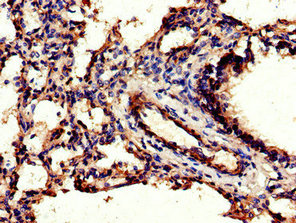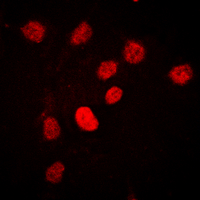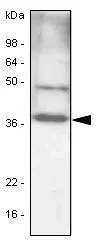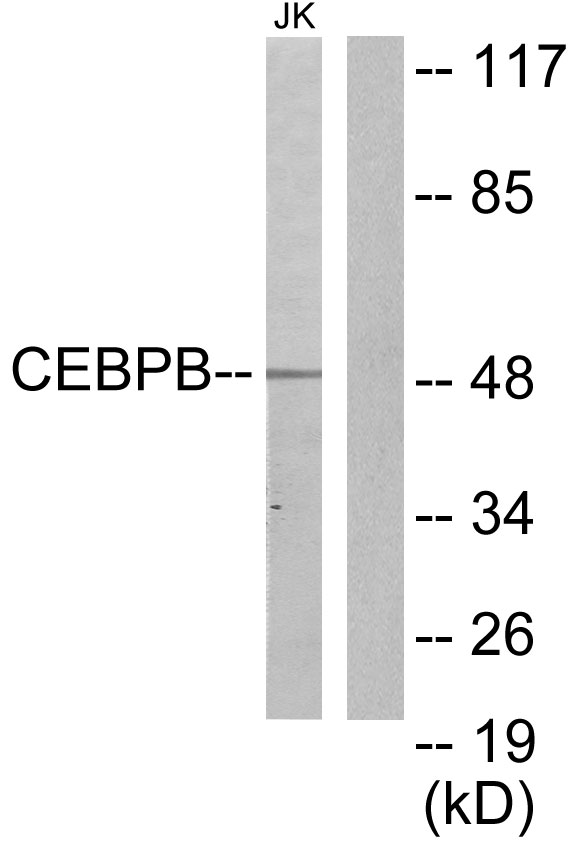C/EBP beta antibody
GTX100675
ApplicationsImmunoFluorescence, ImmunoPrecipitation, Western Blot, ChIP Chromatin ImmunoPrecipitation, ImmunoCytoChemistry, ImmunoHistoChemistry, ImmunoHistoChemistry Paraffin
Product group Antibodies
TargetCEBPB
Overview
- SupplierGeneTex
- Product NameC/EBP beta antibody
- Delivery Days Customer9
- Application Supplier NoteWB: 1:500-1:3000. ICC/IF: 1:100-1:1000. IHC-P: 1:100-1:1000. IP: 1:100-1:500. *Optimal dilutions/concentrations should be determined by the researcher.Not tested in other applications.
- ApplicationsImmunoFluorescence, ImmunoPrecipitation, Western Blot, ChIP Chromatin ImmunoPrecipitation, ImmunoCytoChemistry, ImmunoHistoChemistry, ImmunoHistoChemistry Paraffin
- CertificationResearch Use Only
- ClonalityPolyclonal
- Concentration1.05 mg/ml
- ConjugateUnconjugated
- Gene ID1051
- Target nameCEBPB
- Target descriptionCCAAT enhancer binding protein beta
- Target synonymsC/EBP-beta, IL6DBP, NF-IL6, TCF5, CCAAT/enhancer-binding protein beta, CCAAT/enhancer binding protein (C/EBP), beta, interleukin 6-dependent DNA-binding protein, nuclear factor NF-IL6, nuclear factor of interleukin 6, transcription factor 5, transcription factor C/EBP beta
- HostRabbit
- IsotypeIgG
- Protein IDP17676
- Protein NameCCAAT/enhancer-binding protein beta
- Scientific DescriptionThe protein encoded by this intronless gene is a bZIP transcription factor which can bind as a homodimer to certain DNA regulatory regions. It can also form heterodimers with the related proteins CEBP-alpha, CEBP-delta, and CEBP-gamma. The encoded protein is important in the regulation of genes involved in immune and inflammatory responses and has been shown to bind to the IL-1 response element in the IL-6 gene, as well as to regulatory regions of several acute-phase and cytokine genes. In addition, the encoded protein can bind the promoter and upstream element and stimulate the expression of the collagen type I gene. [provided by RefSeq]
- Storage Instruction-20°C or -80°C,2°C to 8°C
- UNSPSC12352203
References
- Hartl L, Roelofs JJTH, Dijk F, et al. C/EBP-Family Redundancy Determines Patient Survival and Lymph Node Involvement in PDAC. Int J Mol Sci. 2023,24(2). doi: 10.3390/ijms24021537Read this paper
- Zhao H, Lu J, Yan T, et al. Opioid receptor signaling suppresses leukemia through both catalytic and non-catalytic functions of TET2. Cell Rep. 2022,38(4):110253. doi: 10.1016/j.celrep.2021.110253Read this paper
- Du L, Wang H, Liu F, et al. NSP2 Is Important for Highly Pathogenic Porcine Reproductive and Respiratory Syndrome Virus to Trigger High Fever-Related COX-2-PGE2 Pathway in Pigs. Front Immunol. 2021,12:657071. doi: 10.3389/fimmu.2021.657071Read this paper
- Bastola S, Pavlyukov MS, Yamashita D, et al. Glioma-initiating cells at tumor edge gain signals from tumor core cells to promote their malignancy. Nat Commun. 2020,11(1):4660. doi: 10.1038/s41467-020-18189-yRead this paper
- Lin CK, Tseng CK, Liaw CC, et al. Lobohedleolide suppresses hepatitis C virus replication via JNK/c-Jun-C/EBP-mediated down-regulation of cyclooxygenase-2 expression. Sci Rep. 2018,8(1):8676. doi: 10.1038/s41598-018-26999-wRead this paper
- Chen Y, Yan H, Song Z, et al. Downregulation of TNIP1 Expression Leads to Increased Proliferation of Human Keratinocytes and Severer Psoriasis-Like Conditions in an Imiquimod-Induced Mouse Model of Dermatitis. PLoS One. 2015,10(6):e0127957. doi: 10.1371/journal.pone.0127957Read this paper
- Enomoto A, Fukasawa T, Takamatsu N, et al. The HSP90 inhibitor 17-allylamino-17-demethoxygeldanamycin modulates radiosensitivity by downregulating serine/threonine kinase 38 via Sp1 inhibition. Eur J Cancer. 2013,49(16):3547-58. doi: 10.1016/j.ejca.2013.06.034Read this paper



![ELISA analysis of antigen using GTX60489 C/EBP beta antibody [3H9]. Red : Control antigen 100ng Purple : Antigen 10ng Green : Antigen 50ng Blue : Antigen 100ng](https://www.genetex.com/upload/website/prouct_img/normal/GTX60489/GTX60489_20170912_ELISA_w_23061123_371.webp)
![WB analysis of various samples using GTX00915 C/EBP beta antibody [GT1145]. Dilution : 1:1000 Loading : 25 microg](https://www.genetex.com/upload/website/prouct_img/normal/GTX00915/GTX00915_20200508_WB_w_23053121_317.webp)



